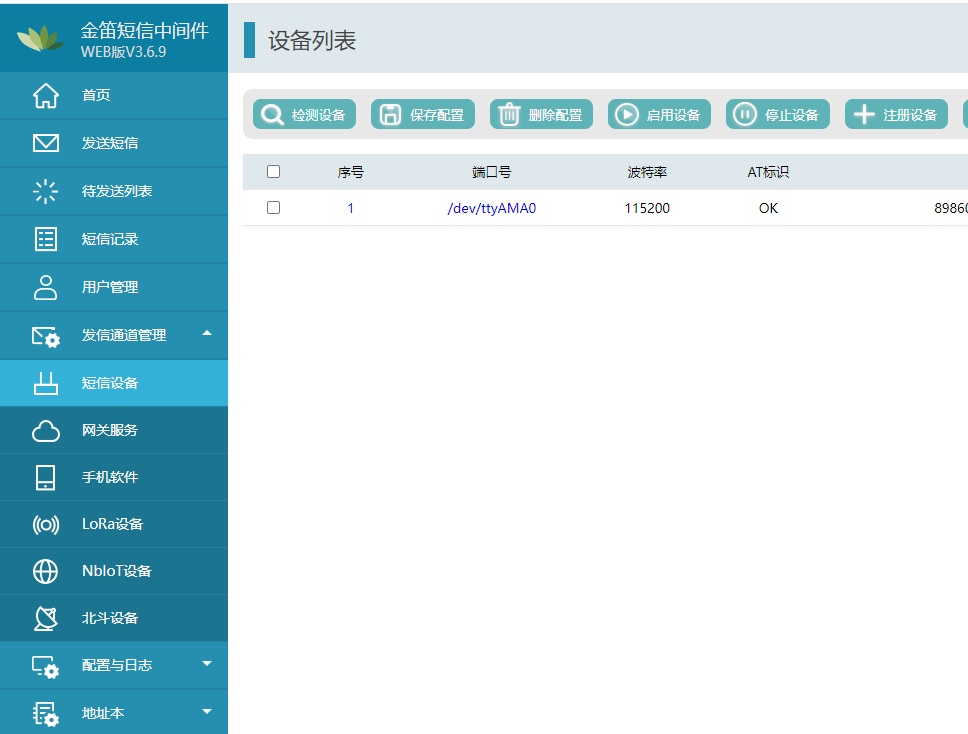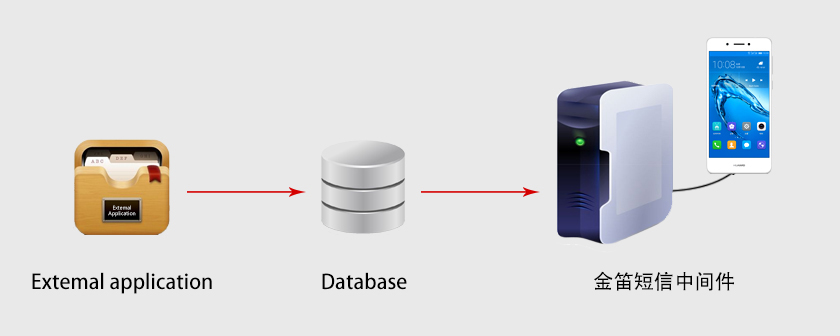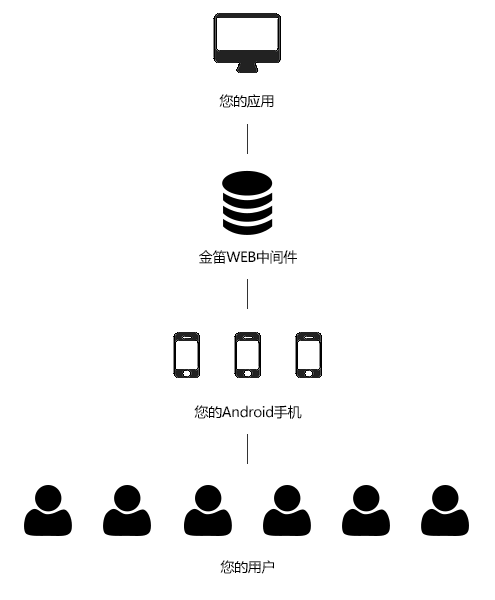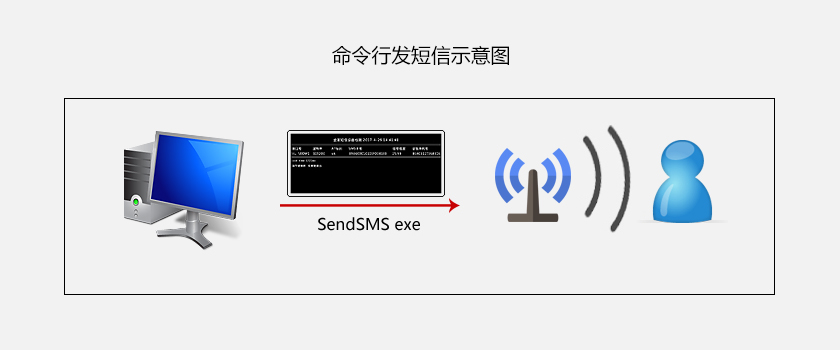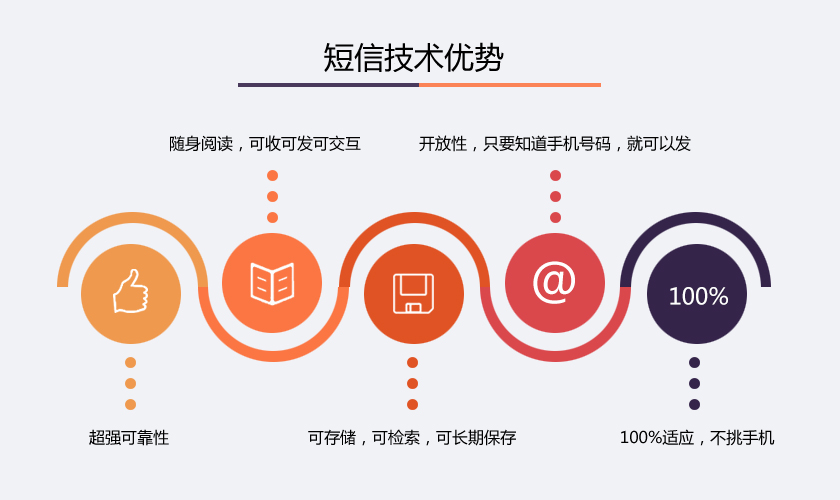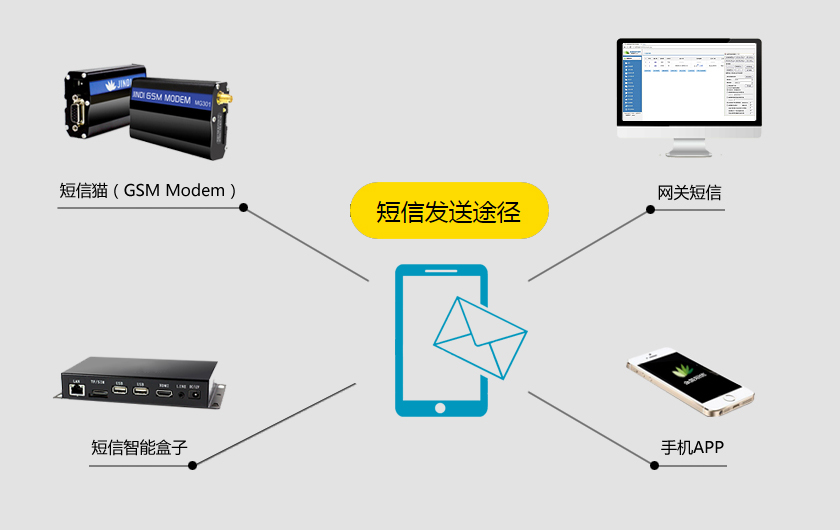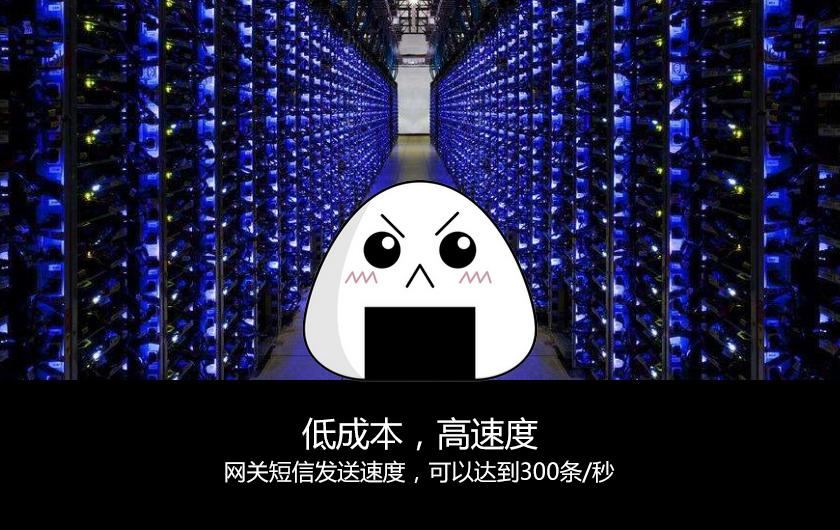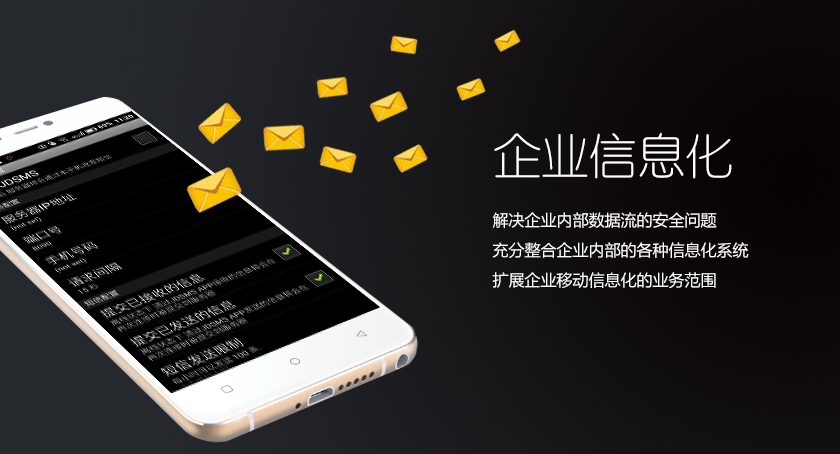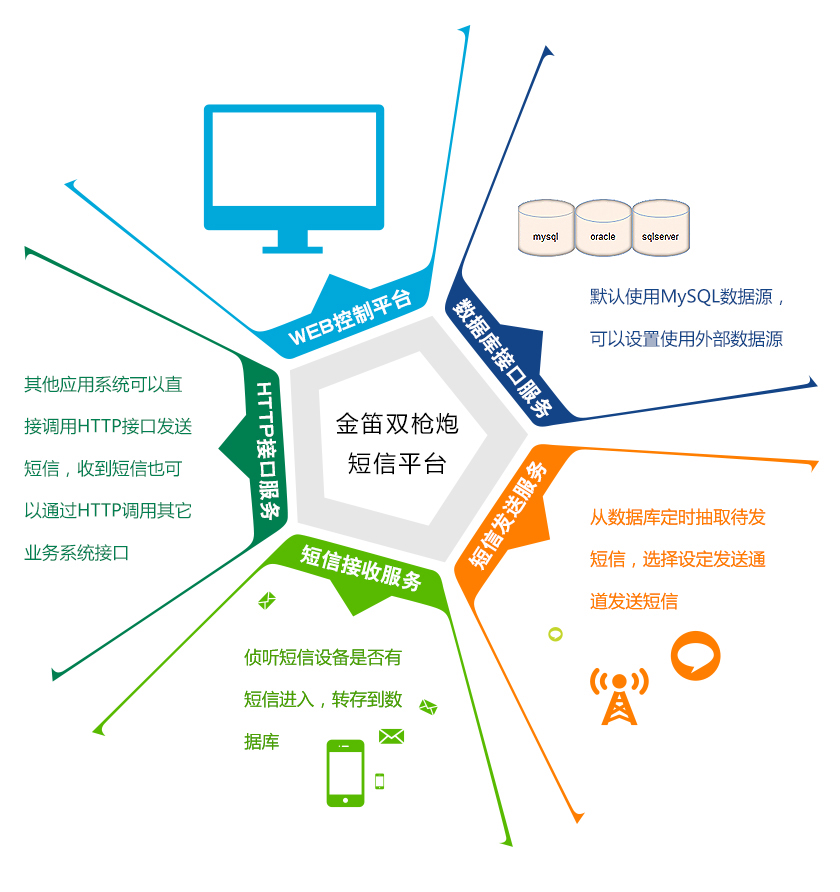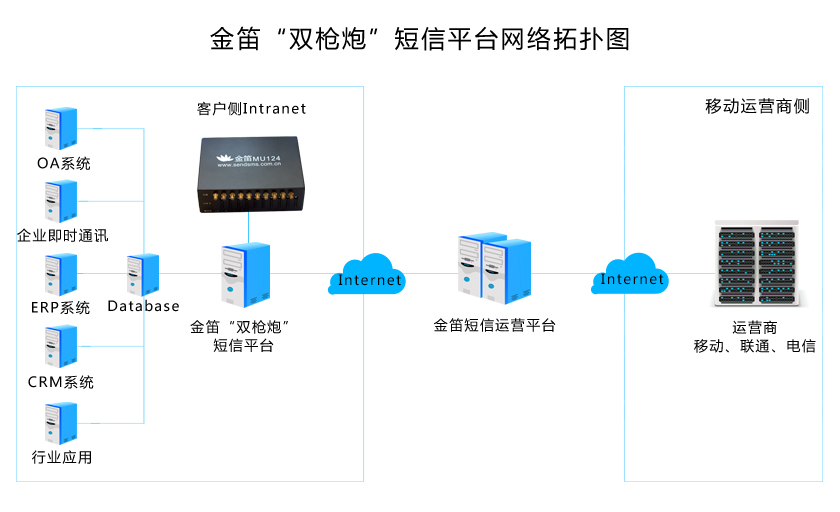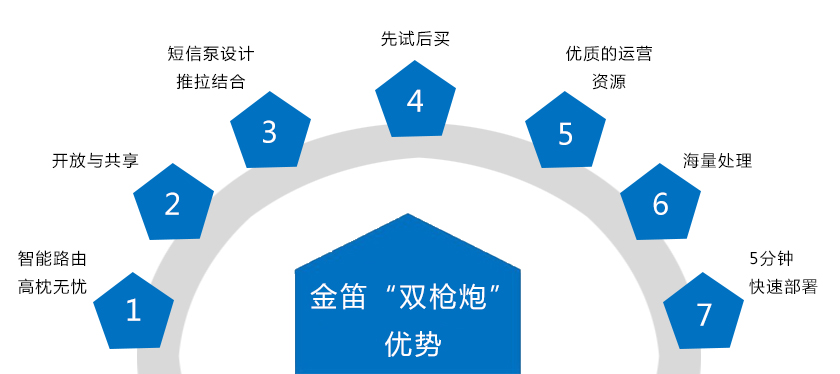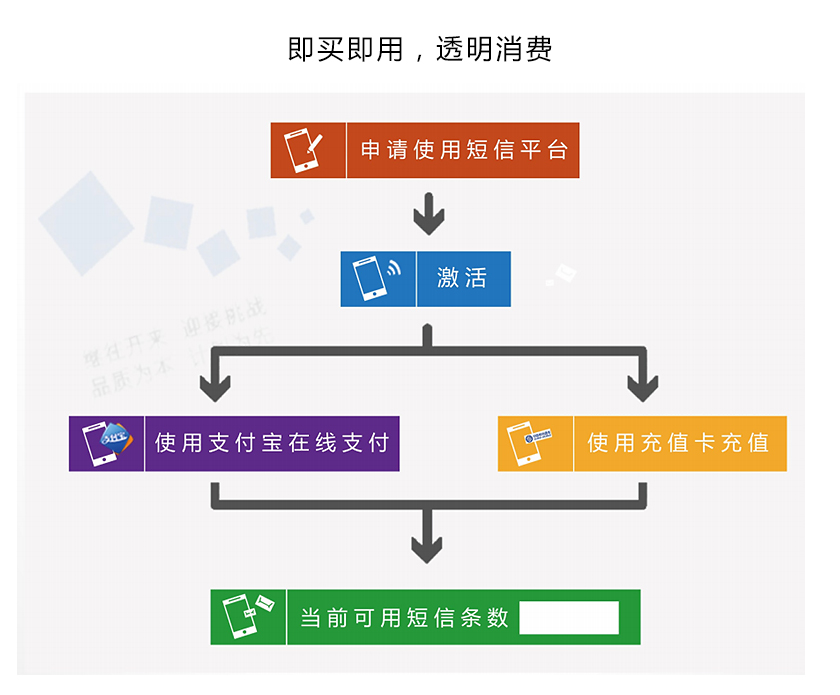Jindi SMS middleware web version

金笛短信中间件web版369
Jindi SMS Middleware Web version is a fist product launched by our company by integrating years of R&D experience and technical accumulation in SMS hardware design and production, SMS software. This product has three characteristics: automatic, intelligent and open. It can automatically detect the SMS device, intelligently monitor the running status of the SMS device, and realize the simultaneous sending and receiving of multiple SMS devices through the open database interface and HTTP interface. In addition to supporting the full range of Jindi SMS terminals, it also supports Jindi Internet of Things terminals, Beidou short message terminals, Lora terminals, and Android mobile phone APP. Through the web version of Jindi middleware, you can build an intranet SMS middleware platform to realize functions such as intranet SMS notification, alarm, and reminder. Through this software, it can help customers reduce the difficulty of development and save development costs. The system is reliable, stable and easy to maintain.
Jindi SMS Middleware Web Edition aims to build an SMS data exchange platform based on hardware devices. The platform breaks down the barriers between LAN, Internet, Internet of Things and mobile operators, and establishes a bridge for people to communicate with people (P2P), things and things (M2M), and people and things (P2M) for SMS.
SMS hardware does not depend on operators, short transmission delay time, reliable and stable, etc., and is widely used in industry, agriculture and service industries. SMS-based hardware development requires programmers to have a certain understanding of the underlying hardware, which is difficult to develop. Jindi SMS Middleware Web Version V3.6.9 is another fist product launched by our company by integrating years of R&D experience and technical accumulation in SMS hardware design and production, SMS software. This product has three characteristics: automatic, intelligent and open. It can automatically detect the SMS device, intelligently monitor the running status of the SMS device, and realize the simultaneous sending and receiving of multiple SMS devices through the open database interface and HTTP interface.
Jindi Software's open platform SMS software product - Jindi SMS middleware, can achieve:
1. Middleware and SMS hardware and SMS gateway are used to deal with SMS hardware and SMS gateway, and SMS is sent and received in a unified manner, so that users do not need to deal with the underlying layer, but only need to deal with the database, which is convenient for secondary development, integration, management and maintenance.
2. The middleware platform provides standard database interfaces and HTTP API interfaces, which unify the simultaneous use of various applications and facilitate the centralized management of SMS. The needs of enterprises for SMS applications are integrated on a unified platform, the interface program is unified, the development of SMS applications is standardized, the maintenance workload is reduced, the work efficiency is greatly improved, and the implementation cost of related applications is reduced.
On the basis of in-depth understanding of customer needs, Jindi continues to innovate, expands leading mobile applications closely related to basic communication, internal office, production control, service marketing, etc., and serves all aspects of enterprises, governments and schools. Whether it is a government customer, a large or even multinational enterprise, as well as a growing small and medium-sized enterprise, Jindi continues to innovate product types, tailor-made solutions, provide the most suitable solutions, meet the various needs of group customers to enhance work efficiency, control communication costs, improve customer satisfaction, and enhance market response speed and competitiveness.
Jindi SMS middleware has the functions of IT application integration, information security management, data management, routing management, and standard communication interface. Good scalability, high security, easy integration, and flexible secondary development. In the process of enterprise mobile informatization, Jindi SMS middleware realizes the seamless connection between mobile terminals and the existing information systems (OA, CRM, ERP) of enterprises through the way of SMS service middleware + mobile phone, and extends various work functions from computers and network platforms to mobile phones. Various functions that can only be operated on a PC can be realized through mobile phones. Jindi SMS middleware provides customers with timely, efficient and fast services, and realizes the instant arrival of massive information.
Jindi provides a full range of SMS solutions that support various operating system platforms, various programming languages, and various connection methods. Among them, Jindi SMS middleware is the core product of our company, which has been developed for many years, with a code volume of more than 100,000 lines, which has been tested for a long time, has first-class stability, and has the function of automatic fault diagnosis and automatic recovery. Through the open database interface, users can use any language to operate the database through SQL to send and receive SMS. As shown in the figure below:
The main features of the web version of Jindi SMS middleware
| 1 | One-click installation and rapid deployment. From installation to sending an SMS, it can be done in 5 minutes, with little to no special setup required. Automatically detect the device, identify the port number and baud rate, and automatically display the port number, baud rate, device model, network signal and other information. |
| 2 | Support a variety of operating systems, WinXP, Win2003, Win7, Win10, Win11, Win2008~Win2019, Redhat, CentOS, Ubuntu, support 32-bit and 64-bit systems, support arm64 domestic operating system. |
| 3 | Two startup modes are supported: Window Service and Command Line Startup. |
| 4 | Support a variety of databases, MySQL, Oracle, SQLServer, Postgresql, support localized databases. It supports automatic creation of database tablespaces, automatic database initialization, and hot switching of databases, without restarting the program, and dynamic switching to the database you want to use. |
| 5 | Messages can be injected in three ways: SQL, HTTP, and MAIL. According to the set port and password, the HTTP URL is automatically generated, and the SMS function can be called through HTTP in other application systems. Provides an HTTP development interface with an interface development routine. |
| 6 | Support web mode management background, administrators can manage the system at home. |
| 7 | It supports up to 64 devices to send at the same time, and supports the mixing of different devices. Each device can be turned on or off individually. |
| 8 | Automatically detect the busyness of the SMS device and automatically load balance the SMS to send SMS. The system can automatically select a port to send SMS, or you can specify a port to send SMS. |
| 9 | Synchronous and asynchronous sending modes are supported. |
| 10 | It supports UCS2, 7-bit, and 8-bit SMS encoding formats. |
| 11 | Support ultra-long SMS sending (up to 500 words, less than 1000 words), support WAP PUSH SMS, support Flash flash message. |
| 12 | Queue management of SMS to be sent. It supports power-off and standby record keeping, and continues to send automatically after recovery. |
| 13 | The failed SMS resend function is supported, and the number of failed resends can be specified. |
| 14 | It supports the SMS callback function, and can immediately call the customized HTTP URL after receiving the SMS, which is convenient for users to further process the received SMS in time. |
| 15 | It supports a full range of SMS devices in Jindi, and can support 64 ports of parallel processing on a single machine. Support Jindi SMS all-in-one machine. |
| 16 | The sending results can be displayed according to success and failure, and the sending results can be sorted by time. |
| 17 | LOG is generated on a daily basis, the logging level can be set, and the log can be downloaded. |
| 18 | Support hot-swap mode, you can directly change the card without shutting down the power or power, and automatically find the network after changing the card. |
| 19 | Support multiple Android phones to send and receive at the same time. |
| 20 | Support gateway SMS sending, support online recharge, effective immediately. |
| 21 | It supports SMS ringing (all hardware models) and SMS voice broadcast (some models), which can be used for mission-critical SMS alarms so that important reminders will not be missed. |
| 22 | The software comes with a watchdog function, which regularly monitors the running status of the hardware device, and automatically resets and initializes the device when it is abnormal. |
| 23 | Support text, Excel format data import, support tree address book. |
The web version of Jindi SMS middleware minimizes the threshold for the development and deployment of SMS devices. So that the majority of programmers do not need to understand the SMS hardware, only need to deal with the database to achieve the SMS function. Through the open database interface and HTTP interface, it is very convenient, fast and reliable to add SMS function to various C/S AND B/S application software. The application of the SMS function makes the information transmission infinitely expanded in space, extremely fast and convenient in time, and at the same time greatly reduces the communication cost and improves the efficiency.
Jindi SMS web version middleware Jindi full range of SMS hardware devices, support Android mobile phones, connect application software, databases and SMS devices or mobile phones to realize SMS notification, SMS alarm, SMS monitoring, SMS data transmission, SMS verification code and other applications. Welcome to download and try it.
The main users of the web version of Jindi SMS middleware are individuals, enterprises, institutions and developers.
Jindi SMS Middleware Web Version Features:
| Home | Welcome page, you can quickly access the sending channel management, data source settings, and SMS sending pages. |
| Send a text message | To manually send an SMS, you can select the sending destination, send the SMS file, select the sending port, and define the sending time. |
| List to be sent | SMS Sending Queue lists SMS messages that have been submitted to middleware but have not yet been sent. |
| SMS logs | Record the content of the sending success, sending failure, and received SMS, destination or source, time, and port number, and search for the content or sort it by the sending time or keyword, and export it as a file. |
| User management | Manage users, provide multi-user login, and set user information, permissions, number of sent messages, etc. |
| Sending channel management | You can manage the SMS sending channels that are currently available in the middleware |
| SMS devices | Detect SMS modem devices, start and stop SMS modems, register devices, and display device status. |
| Gateway services | Configure the login account of the gateway channel and view the current balance. |
| Mobile phone software | Manage the mobile phone sending APP, which displays the mobile phone number, battery level, connection status, boot status, IMEI serial number, mobile phone model and other mobile phone information of the connected mobile device. |
| LORA | IoT module, which can be used for local long-distance information transmission. |
| NBIoT devices | The IoT module can use the IoT operator networking card to communicate between devices. |
| Beidou equipment | The Internet of Things module can use the Beidou communication module to transmit data. |
| Configuration & Logs | |
| Data source settings | Set up a database for middleware. It supports general databases such as MySQL, SQL Server, Oracle, and Postgresql, as well as domestic databases such as Dameng, Shenzhou General, Renda Jincang, and Nanda General. |
| System settings | Configure parameters for the SMS system, HTTP interfaces, and IoT devices. |
| System logs | Record the location of the log file, the time when the file was created, and the file size, and download the specified log. |
| Address book | Record the correspondence between mobile phone numbers and contacts |
| Public address book | Displays the contact details of public contacts, where the content is visible to all users. |
| Personal address book | Displays the contact details of the current user's contacts, where the content is visible only to the currently logged-in user. |
| Change your password | Change the password of the current logged-in user. |
| About middleware | Displays the release date of the current middleware and some necessary parameters, where you can restart the middleware program |
| Exit the console | SECURE EXIT THE WEB MIDDLEWARE LOGIN INTERFACE, WHICH CAN BE USED TO SWITCH USERS. |
Detailed Functions of Jindi SMS Middleware WEB Edition (V3.6.9):
| Send a text message | Send the target | |||
| Send content | ||||
| Send using a form | ||||
| Send time | ||||
| Select the send port | ||||
| Select the SMS suffix | ||||
| List to be sent | Cancel the pending record | |||
| Delete the stop sending record | ||||
| Cancel all pending records | ||||
| Delete all stop sending records | ||||
| SMS logs | Displays the send success record | |||
| Displays a record of sending failures | ||||
| Displays received text messages | ||||
| Delete the record | ||||
| User management | Add a new user | |||
| Modify user information | ||||
| Delete the user | ||||
| Assign permissions | ||||
| Revoke permissions | ||||
| Add/remove the number of messages sent | ||||
| Add a record of the number of messages sent | ||||
| Information backup and recovery | ||||
| User information download | ||||
| There is no limit to the number of entries | ||||
| Restore the limit | ||||
| Sending channel management | SMS devices | Displays the device status | ||
| Automatic detection of the device | ||||
| Save the configuration | ||||
| Delete the device | ||||
| Enable the device | ||||
| Stop the device | ||||
| Enroll the device | ||||
| Configure the network port device | ||||
| Gateway services | application | |||
| activation | ||||
| recharge | ||||
| Displays the number of available records | ||||
| Mobile phone software | Delete the device | |||
| Enable the device | ||||
| Stop the device | ||||
| LoRa devices | Testing equipment | |||
| Save the configuration | ||||
| Delete the configuration | ||||
| Enable the device | ||||
| Stop the device | ||||
| Enroll the device | ||||
| NbIoT devices | Testing equipment | |||
| Save the configuration | ||||
| Delete the configuration | ||||
| Enable the device | ||||
| Stop the device | ||||
| Add a virtual appliance | ||||
| Enroll the device | ||||
| Beidou equipment | Testing equipment | |||
| Save the configuration | ||||
| Delete the configuration | ||||
| Enable the device | ||||
| Stop the device | ||||
| Enroll the device | ||||
| Configuration & Logs | Data source configuration | Select the database type | ||
| The IP address of the server | ||||
| Database connection port | ||||
| Database username | ||||
| Database password | ||||
| The name of the database | ||||
| Single-time processing volume | ||||
| The number of failed sending attempts | ||||
| Database connection test | ||||
| Database initialization | ||||
| Database configuration information is saved | ||||
| Acknowledgment of receipt of mail | ||||
| System settings | Basic settings | The main switch for the transmit channel | SMS device (on/off) | |
| Mobile App (On/Off) | ||||
| Gateway Channel (On/Off) | ||||
| LoRa devices (on/off) | ||||
| NbIoT devices (on/off) | ||||
| Beidou equipment (on/off) | ||||
| Logging level | DEBUG | |||
| INFO | ||||
| WARN | ||||
| ERROR | ||||
| FATAL | ||||
| Channel priority | SMS Device - Gateway - Mobile Phone | |||
| SMS device - mobile phone - gateway | ||||
| Gateway - SMS device - mobile phone | ||||
| Gateway-phone-SMS device | ||||
| Mobile phone - SMS device - gateway | ||||
| Mobile phone - gateway - SMS device | ||||
| SMS suffix | ||||
| SMS device settings | Receive SMS processing | Delete the text messages from the SIM card once they are received | ||
| Sending and receiving priority settings | Send first | |||
| Receive priority | ||||
| Whether to register for the GSM network | enroll | |||
| Not registered | ||||
| Multi-device operation mode | Sync mode | |||
| Asynchronous mode | ||||
| SMS Extended Alerts | not | |||
| Ringing, the duration of ringing | ||||
| Voice broadcast | ||||
| SMS signature | ||||
| Receiving polling interval | ||||
| Sending polling interval | ||||
| The maximum speed at which SMS can be sent | ||||
| Ring duration | ||||
| Gateway SMS settings | Send Polling Interval (Gateway) | |||
| SMS signature of the gateway user | ||||
| Mobile APP settings | The number of SMS messages picked up by the app at a time | |||
| The timeout period of the mobile phone connection | ||||
| Send Polling Interval (App) | ||||
| Maximum number of sends per phone per month | ||||
| Billing cycle | Start time | |||
| End time | ||||
| Email-to-SMS settings | Get a mobile phone number | Extracted from the topic | ||
| Extract from content | ||||
| Specify the number | ||||
| Get the content of the delivery (valid when the number is specified) | Extracted from the message header | |||
| Extracted from the message body | ||||
| Configure the SMS sending and receiving API of HttpServer | port | |||
| Protocol type | Enable HTTPS encryption | |||
| Send a password | ||||
| Receive a password | ||||
| Test tools | ||||
| Document downloads | ||||
| SMS sending URL | http://127.0.0.1:8060/send?password=[password]&text=[text]&recipient=[cell-phone-number]&encoding=U | |||
| SMS receiving URL | http://127.0.0.1:8060/read?password=[password]&gateway=modem[id]&count=[number] | |||
| SMS sending status URL | http://127.0.0.1:8060/sendstatus?msgid=[msgid] | |||
| Usage examples |
http://192.168.0.169:8060/send?password=1&recipient= 10086&text=ceshi&encoding=U |
|||
| Callback API settings | Callback the status of the interface | Enable callbacks | ||
| Protocol type | GET | |||
| POST | ||||
| Callback URL | ||||
| The callback failure retry interval | ||||
| The number of days between callback failures | ||||
| NbIoT system settings | MQTT server | |||
| MQTT server communication port | ||||
| The username of the MQTT server | ||||
| MQTT server login password | ||||
| The main switch of the sending channel | Low (information may be lost or duplicated) | |||
| Medium (information will not be lost and may be duplicated) | ||||
| High (information will not be lost, will not be duplicated) | ||||
| Send interval | ||||
| NbIoT polling interval | ||||
| NbIoT receive interval | ||||
| LoRa system settings | LoRa information key | |||
| Send interval | ||||
| LoRa polling interval | ||||
| LoRa receive interval | ||||
| Beidou system settings | Number of servants | |||
| Send interval | ||||
| Beidou polling interval | ||||
| Beidou reception interval | ||||
| All-in-one TCP/IP settings | Use the IP address below | IP address | ||
| Subnet mask | ||||
| Default gateway | ||||
| Use the DNS server address below | DNS servers are preferred | |||
| Alternate DNS server | ||||
| System logs | Delete | |||
| Download | ||||
| Address book | Public address book | A new directory has been added | ||
| Delete the directory | ||||
| Import | ||||
| Export | ||||
| Address book details | increase | |||
| Delete | ||||
| Personal address book | A new directory has been added | |||
| Delete the directory | ||||
| Import | ||||
| Export | ||||
| Address book details | increase | |||
| Delete |
Comparison of the functions of the VC version and the WEB version of Jindi SMS middleware
| Jindi middleware VC version | JINDI MIDDLEWARE WEB VERSION | ||
| operating system | winxp | √ | √ |
| win2003 | √ | √ | |
| win7~win10 | √ | √ | |
| win2008~win2019 | √ | √ | |
| redhat | √ | ||
| centos | √ | ||
| ubuntu | √ | ||
| Mode of operation | service mode | √ | √ |
| Database management | access | √ | |
| mysql | √ | √ | |
| oracle | √ | √ | |
| sqlserver | √ | √ | |
| Localized database | √ | ||
| Device management | Automatic detection of the device | √ | |
| Automatic equalization of sending | √ | √ | |
| Signal strength | √ | ||
| Connection status | √ | ||
| Working status | √ | ||
| Receiver and transmit switches | √ | ||
| Information management | Multiple ports are sent at the same time | √ | √ |
| Automatically create database table structures | √ | √ | |
| REMOTE MANAGEMENT VIA WEB | √ | ||
| Send mode (synchronous/asynchronous) | √ | ||
| Specify the port to send | √ | √ | |
| Queue management for pending SMS | √ | √ | |
| Failed SMS retransmission | √ | √ | |
| When you receive an SMS, the database will be automatically dumped | √ | √ | |
| SMS receipts | √ | ||
| SMS reception interval | √ | ||
| SMS sending intervals | √ | ||
| Call the API | PL/SQL | √ | √ |
| HTTP URL | √ | ||
| SDK | √ | √ | |
| SMS encoding format | UCS2、7bit、8bit | √ | √ |
| wappush text messages | √ | √ | |
| Extra-long text messages | √ | √ | |
| Flash message | √ | ||
| Support SMS devices | Jindi 2G series | √ | √ |
| Jindi 4G series | √ | √ | |
| Jindi 5G series | √ | ||
| Registration code authorization | Authorization by port | √ |
SMS has become the most reliable way to communicate. Through the mechanism of storage and forwarding, SMS provides highly reliable and 100% compatible with various mobile phone data services, and its timely, cheap and convenient communication function has become the preferred way for alarm, notification and authentication code.
There are four ways to send SMS: SMS device, SMS gateway, mobile APP, and SMS all-in-one machine.
Jindi SMS middleware completes the function of sending and receiving mobile phone SMS. It can connect with multiple SMS devices and multiple SMS gateways to send SMS to a specified mobile phone within a specified time. Jindi SMS middleware can also periodically check the callback SMS and save it in the database. The subsequent processing of this information is carried out by other systems. The sending service system adopts multi-threading and queue design, and has the ability to smooth out peaks and automatically connect/revoke. The sending server can connect multiple SMS devices and SMS gateways at the same time, and can ensure the independence of each other, so that if one connection fails, the other connections can function normally.
SMS middleware is an information integration system, and a lot of information comes from other computer application systems. The interface service completes the work of importing information from other application systems into the SMS middleware. The interface service completes the function of obtaining other system information. Information can be obtained in the following ways:
(1) The function of data pump is to initialize several tables in the database of the external system, detect the data changes of the tables regularly, and extract the SMS to be sent.
(2) The connection interface of the application system. Accept information that is "pushed" by other applications.
There are two ways to access industry application system information:
(1) Directly access the database of SMS middleware to be sent. The content of the SMS and the mobile phone number that need to be sent will be automatically imported into the content to be published through the program;
(2) Push human data by the application system. It's a way of reactive service. The middleware accepts the data sent by other application systems through HTTP, and after parsing and sorting, it is stored in the middleware database, and then the sending service extracts it from the database to complete the work of sending data.
The WEB version of Jindi SMS middleware supports these three methods at the same time, providing three interfaces: database, HTTP, and Email, so that any application software can easily access the SMS service.
As an alarm notification application, SMS reliability comes first. Jindi SMS middleware WEB pushes reliability to a new height through SMS device monitoring, SMS failure retransmission, and mutual backup of multiple sending links.
Text messaging is a productivity tool
With the development of smartphones, everyone uses WeChat, but it cannot replace SMS. The former is a social tool, and the latter is a productivity tool. Just like QQ can't replace Mail. SMS is also evolving, with long text messages of up to 200 words on ordinary mobile phones and 1,000 words on smartphones. The SMS communication storage and forwarding mechanism and the voice channel mechanism are inherently unparalleled and 100% adaptable to all kinds of mobile phones, which can be used for critical transactions.
Among today's many mobile data services, SMS service provides reliable and low-cost portable information services through the mechanism of storage and forwarding and real-time monitoring, which is the most important, convenient and popular means of mobile data communication at this stage. It has changed people's lives and has become an important tool for people to access information and master their lives anytime, anywhere. The emergence of short messages, to a certain extent, has promoted the formation of the "mobile data business" industry.
The characteristics of Chinese characters determine that a text message, 70 Chinese characters can explain 99% of the content of daily communication. The development and compatibility of long SMS technology will make SMS a communication medium that will have a huge impact on public life for a long time to come.
At present, there are four types of SMS sending channels: gateway SMS, GSM modem (commonly known as SMS modem), mobile APP, and SMS all-in-one machine.
1. The gateway SMS sending speed is fast, which can reach 300 messages/second, which is suitable for group enterprises and government public services, and needs to be able to connect to the Internet.
2. GSM modem is equivalent to a ruggedized mobile phone in principle, compared with ordinary mobile phones, GSM modem transmission speed, signal indicators, uninterrupted working hours and other indicators have been improved, GSM modem usually uses serial port or USB port data cable to connect with the computer, that is to say, only a computer, a GSM modem can realize automatic SMS sending and receiving work, no need to connect to the Internet.
3. The mobile APP is to install an app on the android mobile phone, and the APP connects to the Jindi SMS middleware through wifi to realize SMS sending and receiving.
4. SMS all-in-one machine, software and hardware all-in-one machine, with higher reliability.
Problems with the SMS app
Some companies do not know how to integrate SMS platforms, and some have already integrated SMS, and often face the following problems:
1. Integrate the SMS function in the application system, most of the OCX and DLL provided by SMS hardware manufacturers do not consider the problem of multi-threading, and do not consider the problem of hardware device fault detection and fault recovery.
2. When using the SMS gateway, most of them only provide HTTP interface or WebService interface, and the workload of secondary development and integration is relatively large. It also often encounters the problem of gateway blocking, gateway renewal and recharge. It is difficult to maintain in the later stage and has a large workload.
Enterprise group users can deploy the SMS middleware in the local area network of the enterprise, and then as long as it is connected to the Internet, the data flow and business flow on various application servers in the enterprise can be extended to the mobile phone terminal, which not only solves the security problem of the internal data flow of the enterprise, but also can fully integrate various information systems within the enterprise, greatly expanding the business scope of enterprise mobile informatization. The meaning of the enterprise SMS platform is:
(1) Extension terminal of enterprise information system;
(2) the information source that the employee carries with him;
(3) The link between enterprises and employees, between customers, and between upstream and downstream suppliers.
Jindi SMS middleware is becoming more and more mature in terms of operation technology and operation mode, and it is undoubtedly a top priority for enterprises to better apply this valuable resource. SMS middleware uses various information systems in the enterprise as the data source and the mobile phones of enterprise employees as the output terminal, forming a real-time and convenient information coverage network. In terms of information acquisition, the platform needs to obtain information from other professional systems such as management information system (MIS), office automation system (OA), enterprise internal website, real-time monitoring system, etc. There are 2 ways to obtain it:
One is that the SMS middleware accesses an external data source (for example, accesses the database of an external system through JDBC) based on a predefined database interface to obtain SMS sending information.
The other is that the SMS platform has built some form of information interface (Web service, HTTP API), through which the external system actively pushes the information. The coexistence of these two methods can solve the attribute requirements of different information, so as to better serve users.
Jindi SMS middleware is closely integrated with the application system, which provides a good way for enterprises to improve the timeliness and effectiveness of information transmission, and has achieved good results in the application.
Jindi SMS middleware consists of a database, a Web service built on top of the database, a sending service, and a receiving service. It works in the following ways: a user interface with a B/S structure composed of web services, which allows users to manage the platform; The sending and receiving service is connected to an external SMS device and an SMS gateway to send and receive information.
(1) Delivery services. Periodically scan the database for data changes and send it to be sent. Currently, MySQL, SQLServer2000/SQLServer2005-2012, Oracle and some localized databases are supported.
(2) Receiving services. Process incoming SMS messages at any time and transfer the received SMS messages to the database.
(3) Web services. It is the main function server of the platform, which includes: personal functions for all users, and administrative configuration functions for system administrators. These functions are implemented in the form of the Web, so that any computer in the network (Internet or intranet) does not need to install any software, and can use the platform directly through the browser.
Main advantages of Jindi SMS middleware:
1. The system is a multi-person system of the nature of the platform, and its structure is B/S mode, which ensures the multi-person use in a large geographical range.
2. The system is equipped with a sending service, which is an unguarded and self-running service system, which can send instant and timed text messages. Compared with the existing similar system, which can only send instant text messages by full-time personnel, there is a great improvement.
3. The system is equipped with interface services, making it a data integration system. Its emergence makes a large number of data from other information systems in the enterprise automatically import into the system, and organize it into a standard SMS sending form, and send it according to the specified audience and time.
4. In the sending service and receiving service, a large number of multi-threading and queue technologies are used to ensure the effective and stable operation of SMS middleware.
5. Realize a variety of data import methods. Including direct information entry, document (text, excel) guidance, database import, application system data pushing, etc.
Since the launch of the system, it has achieved good results, which are manifested in the following aspects:
(1) All authorized users of the internal LAN can use the function of SMS middleware. Including the interview notice of the human resources department, the salary payment SMS reminder of the finance department, the financial announcement, the meeting notice of the administrative department, the news bulletin, and the holiday greetings of the customers of the sales department are all sent through the SMS middleware, so that the information can be transmitted efficiently and quickly;
(2) SMS middleware is connected to multiple internal software systems, which can automatically integrate data and send SMS without human intervention. Typical connection data is:
1) Office automation system (O A system);
2) MIS management information system, etc.;
3) Customer relationship management system;
4) Order management system;
5) Computer room monitoring and alarm system;
6) SMS reminder after the website demand form is submitted.
Due to the interface with multiple application systems, it greatly improves the office efficiency of the enterprise, saves human resources, and satisfies customers and employees.
SMS middleware is an SMS service platform software deployed on a local area network, intranet or Internet.
Open and shared
Values and benefits for users:
(1) Unified interface and easy management: Unified SMS sending and receiving platform to avoid SMS interfaces of multiple application systems. It is convenient for the standardization of background management.
(2) Platform-based and easy to expand: Unified specification of application development, through standard database and HTTP interface, each application uses a unified SMS service.
(3) More secure: Implement SMS sending authentication, and do not send non-authenticated SMS requests within the enterprise.
(4) More efficient: It can greatly reduce the maintenance workload of the SMS module of the relevant system, improve work efficiency and reduce work errors.
(5) Cross-platform: Cross-platform and cross-regional distributed deployment can be realized. Web services and databases can be divided into different servers, and hardware devices and SMS middleware can be deployed on different servers, which is very convenient to use and maintain.
SMS pump design, push and pull combination
SMS data pumping. Pull data information from other systems to the SMS system through the database interface. or real-time processing of data "pushed" by other application systems via HTTP.
SMS data routing. SMS middleware selects the appropriate SMS channel and SMS channel according to the four pre-set operation modes, such as "device only sending", "gateway sending only", "device priority sending", and "gateway priority sending", and automatically balances the sending between different channels of the same type of channel.
SMS data pumped out. Through the queue and caching mechanism, the SMS middleware is connected to the SMS hardware device or connected to the server of the Jindi SMS Operation Center to send SMS messages, and the failure result is recorded after a certain number of retransmissions.
"Dual-gun" SMS middleware - supports both SMS hardware and SMS gateway dual-channel and dual-channel SMS sending. The advantages of the two sending methods complement each other, which effectively improves the sending speed and delivery success rate.
Jindi "Double Guns" SMS Middleware - Jindi technology, independent intellectual property rights, software and hardware mutual support, "push" and "pull" can be used, unique in the industry. IT SUPPORTS MULTIPLE SMS DEVICES AND MULTIPLE SMS GATEWAYS, AND SUPPORTS MULTIPLE SENDING CHANNELS IN TWO WAYS, AND ACTIVELY EXTRACTS (POLL) AND PUSHES (PUSH) SMS THROUGH THE DATABASE INTERFACE AND HTTP INTERFACE.
Dual guns: Using the industry's unique software and hardware dual-channel technology, it supports SMS hardware devices (multi-channel SMS modem, cat pool) and SMS gateway (multi-channel), and can specify device priority or gateway priority to send, and the system can continue to send through another channel in the event of network failure or hardware failure. With both transmission speed and high reliability, it is widely used in national earthquake network, highway dispatching, punctual notification along high-speed rail, flash flood warning and other projects. Jindi SMS middleware is deployed on the customer's own server, supports "push" and "pull" two ways, and adopts the customer's local database interface and local HTTP interface, so that the data security, reliability and SMS sending speed are guaranteed. It supports local databases and JDBC external data sources, MySQL, SQLServer2000, SQLServer2005-2012, Oracle, etc., and is easy to integrate with various industry application software such as enterprise OA and CRM.
Smart Routing for peace of mind
Jindi SMS middleware is queued in a database to avoid the phenomenon of packet loss sent in large quantities by similar software; The failure retransmission mechanism, device priority mechanism, and gateway priority mechanism effectively improve the delivery success rate and control the sending cost.
Intelligent detection and automatic identification of hardware devices.
SMS messages can be load balanced and intelligently routed across multiple devices.
Web-only configuration management facilitates remote maintenance.
Multi-user and user-based quotas are supported.
Specified channel transmission and scheduled transmission are supported.
Callback service after receiving SMS (HTTPClient) is supported.
The SMS middleware of the general interface only provides HTTP interfaces, and can only submit SMS messages in PUSH mode. The special feature of Jindi Dual Gun SMS Middleware is that it supports the automatic POLL mode of the database, which automatically extracts SMS messages at regular intervals.
You can connect to external data sources through JDBC to automatically initialize the database, what to send, and when to send, everything is in your control.
When an emergency occurs, a large amount of data to be sent may be poured into the SMS middleware instantaneously, and the platform uses the database to queue and send it in turn according to the first-in, first-out principle to ensure that the SMS is never lost.
When using SMS middleware in multiple systems at the same time, you can specify the priority of SMS, with the highest priority being sent first, and the emergency SMS being sent immediately to ensure that the emergency event is not missed.
Try before you buy
Jindi SMS middleware is released in the form of a software installation package, which can be www.dyc.cn directly from the website. After downloading and installing, enter the software background and use Alipay to buy 1 SMS for 0.1 yuan to try out.
1. Jindi SMS middleware uses high-quality gateways for the whole network, fully supports mobile, China Unicom, and telecom, and integrates three networks into one, with fast speed, stable quality and high arrival rate.
2. The gateway has multi-channel guarantee, providing users with multiple high-quality standby SMS gateways, and automatically selecting the optimal channel according to the actual situation of the channel when sending, so as to ensure the efficiency of user sending.
3. Real-time failure monitoring and processing mechanism.
4. Jindi SMS middleware + Jindi industrial-grade hardware equipment, after long-term operation verification, can achieve 365 days X 24 hours of highly reliable operation.
5. Advanced bad information filtering system to ensure long-term and stable use by regular users.
6. High security, high confidentiality, using a variety of technologies and measures to keep customer information and materials strictly confidential.
7. 7X24 solves user problems in a timely manner and provides software upgrades.
Massive processing
1. Multi-threading and caching technology are adopted to support massive data processing.
2. Multi-channel automatic shunt and multi-gateway automatic reissuance.
Rapid deployment in 5 minutes
1. It only takes 5 minutes to install. Save your valuable time.
2. It only takes 2 hours to 2 days to complete the connection between the business system and the platform.
3. The online Alipay recharge is fully automatic, and the number of SMS messages purchased after the recharge is completed will be automatically recharged into the account, which only takes 2 minutes. Charge as you go, transparent consumption.
